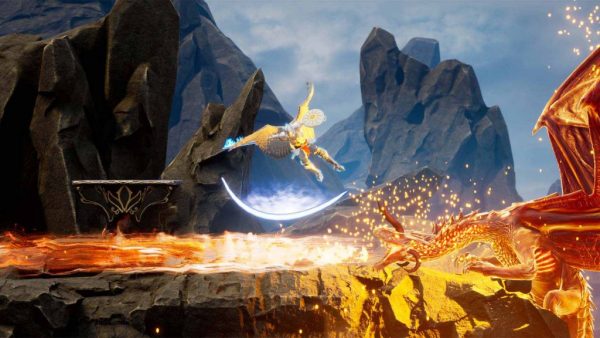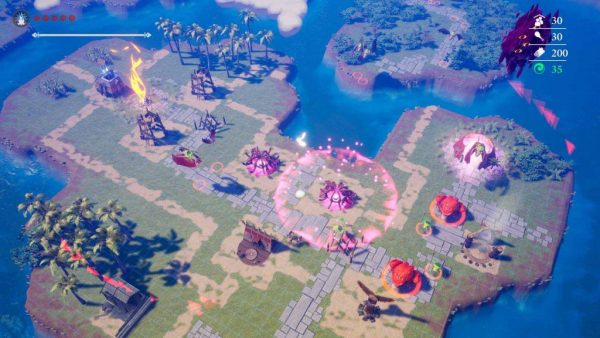Also On: Xbox One, Switch, PC
Publisher: SEGA
Developer: ACE Team
Medium: Digital
Players: 1
Online: No
ESRB: E
SolSeraph is the newest title from Zeno Clash & Rock of Ages developer ACE Team. While those titles were wholly unique, and certainly strange, SolSeraph is instead heralded as a spiritual successor to SNES classic ActRaiser. And, for the most part, it delivers on that concept. Blending 2.5D action-platforming with a top-down tower defense / base-building RTS mechanic, SolSeraph does feel like an updated version of ActRaiser. However, with SolSeraph?s attention split between two different game types, it never feels like it nails either side of these two gameplay mechanics, and as a result ends up being a lackluster experience overall.
In SolSeraph you take on the role of Helios, an angel tasked with protecting humanity against various threats conjured up by the jealous Younger Gods. Armed with a sword, shield, and a variety of magical powers, you?ll spend part of the game running through 2D style stages with 3D visuals, battling against goblins, bat riders, skeleton warriors, and other fantasy styled foes. There are essentially two types of action stages, ones that feel more traditional with scrolling from left to right and generally culminating in a boss fight, while the other is made up of a confined space where you?ll defeat waves of enemies before finishing. Completing stages will yield health and mana upgrades, and occasionally you?ll be granted new powers or upgrades to your existing spells.
 Combat is fairly basic, Helios has a limited three swing combo for quick button presses, a shield to block projectiles, and a back-step dodge. For spells you can fire your bow and arrow with limited use early on, but you?ll quickly gain access to things like self-heals, lightning, and so on. While Helios is easy enough to control, the controls also never feel as tight as you?d like. I?d often find myself over-jumping into enemies or hazards, mistiming weapon swings, and overall Helios movement never feels all that great. That?s a little vague, I know, but difficult to describe until you actually pick up the controller. Coming from something with tighter, more satisfying player control like Bloodstained to this was a bit of a shock really.
Combat is fairly basic, Helios has a limited three swing combo for quick button presses, a shield to block projectiles, and a back-step dodge. For spells you can fire your bow and arrow with limited use early on, but you?ll quickly gain access to things like self-heals, lightning, and so on. While Helios is easy enough to control, the controls also never feel as tight as you?d like. I?d often find myself over-jumping into enemies or hazards, mistiming weapon swings, and overall Helios movement never feels all that great. That?s a little vague, I know, but difficult to describe until you actually pick up the controller. Coming from something with tighter, more satisfying player control like Bloodstained to this was a bit of a shock really.
I?m also not a huge fan of the level layout for the longer action stages. Enemies will move into the 2D combat plane from either the background or foreground, so you?ll often see them coming before you can hit them. But some enemies can still strike at you as they move to the center, and for flying enemies it gets difficult to tell when they?re actually in range especially when they come from the background. It feels like a very unnecessary way of spawning enemies, and ends up being more frustrating than neat. Also, while the game will highlight bottomless pits, it doesn?t allow for any limited scroll function to look up and down on stages with vertical areas. So you?ll often drop down from platforms and land on damaging brambles, enemies, or other hazards with no indication of what was below you.
 The real-time strategy / tower defense side of SolSeraph ends up being the better part of the experience, but again, it?s not quite as enjoyable as other full-fledged tower defense games on the market today. To begin, Helios will pick a location on the map infested with evil, which in turn leads to another overworld map where the humans you?re tasked with protecting reside. At this point, Helios becomes a small pointer on the map that you?ll move about with the analog sticks. You can build structures, like homes, farms, lumber mills, and so on, in order to increase the overall population and provide resources. You?ll then pour those people and resources into defense buildings, which expand over time and are necessary to fend off waves of enemies attempting to destroy a central point in your burgeoning village.
The real-time strategy / tower defense side of SolSeraph ends up being the better part of the experience, but again, it?s not quite as enjoyable as other full-fledged tower defense games on the market today. To begin, Helios will pick a location on the map infested with evil, which in turn leads to another overworld map where the humans you?re tasked with protecting reside. At this point, Helios becomes a small pointer on the map that you?ll move about with the analog sticks. You can build structures, like homes, farms, lumber mills, and so on, in order to increase the overall population and provide resources. You?ll then pour those people and resources into defense buildings, which expand over time and are necessary to fend off waves of enemies attempting to destroy a central point in your burgeoning village.
You?ll know when a wave is coming based on a meter at the bottom of the screen, and you can trigger the wave early if you?d like, but generally you?ll find yourself wishing for more time instead. All of the fighting is controlled by the A.I. which does well enough, but you can also get a little more hands on with a limited set of angelic controls, like lightning, that allow you to target and damage incoming units. You?ll be doing all of this, fending off waves of enemies and expanding your population, so that you can eventually build temples that will dispel evil fog around enemy lairs, allowing Helios to invade that lair which in turn triggers the action-adventure phase of the gameplay.
 Again, I found the base building and tower defense portions to be more enjoyable than the general side-scrolling action bits, but there?s just not enough bells and whistles to go along with it. You?re limited to constructing two resources, food and wood, which in turn allows your population to grow and building options to expand. However, early on you?ll discover it?s almost more beneficial to quickly build roads (which cost nothing) that stretch out to each enemy lair on the map, and then build your temples near those lairs as quickly as possible. From there Helios can just jump from lair to lair, and once done, take on the boss stage. There?s little incentive to expanding your town, despite the large size of the maps, and the enemy waves increase in difficulty so much that even if you try to focus on building up your civilization, the enemy hordes start to outclass you before you get too far.
Again, I found the base building and tower defense portions to be more enjoyable than the general side-scrolling action bits, but there?s just not enough bells and whistles to go along with it. You?re limited to constructing two resources, food and wood, which in turn allows your population to grow and building options to expand. However, early on you?ll discover it?s almost more beneficial to quickly build roads (which cost nothing) that stretch out to each enemy lair on the map, and then build your temples near those lairs as quickly as possible. From there Helios can just jump from lair to lair, and once done, take on the boss stage. There?s little incentive to expanding your town, despite the large size of the maps, and the enemy waves increase in difficulty so much that even if you try to focus on building up your civilization, the enemy hordes start to outclass you before you get too far.
Even if you have fond memories of the original ActRaiser, I?m not sure that I could wholeheartedly suggest checking out SolSeraph. It absolutely is a successor to the SNES original, but I found myself increasingly disappointed and frustrated with the gameplay loop, and could only think of how much better the game would be if it had focused on one central mechanic instead of splitting attention between the two. One the plus side, it does have a fantastic soundtrack, and the visuals generally look really nice between the two modes. Unfortunately, that?s about the biggest selling point, and isn?t enough to make SolSeraph stand out compared to other retro-inspired releases.
Note: SEGA provided us with a SolSeraph PS4 code for review purposes.

